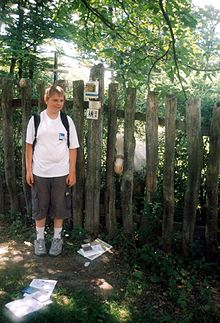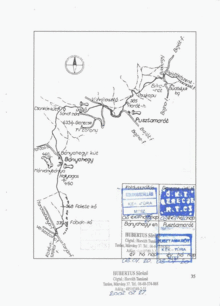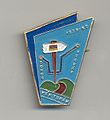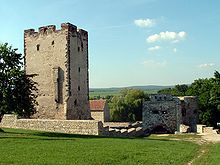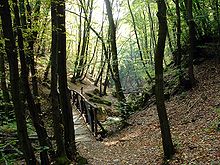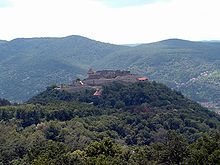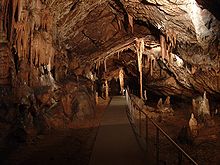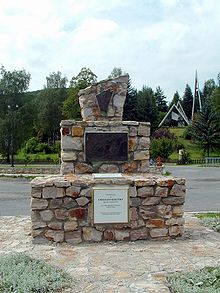- Countrywide Blue Tour in Hungary
-
The Countrywide Blue Tour (in Hungarian: Országos Kéktúra, Kéktúra or simply OKT) is a part of the Hungarian section of the European Long Distance Walking Route E4. The route starts atop the Irottkő Mountain (884 m) on the Austrian-Hungarian border then cuts across Hungary eventually ending 1,128 km later at the village of Hollóháza by the Hungarian-Slovakian boundary. The name of the Kéktúra (Blue Tour) is a reference to the marking of the path itself: it is a horizontal blue stripe between two white stripes.
During its course the Blue Tour visits arguably the most beautiful natural and man-made sights of Hungary, e.g. more than a dozen forts and castles, lookout towers, three World Heritage Sites of Hungary (the panorama of Budapest from the hills, the old village of Hollókő and the Stalactite Cave of Aggtelek), Lake Balaton, the Danube Bend, and the spent volcanoes of the Basin of Tapolca, etc.
According to the latest survey conducted in 2007 utilizing the Global Positioning System, its total length was measured to be 1128.2 km and the total elevation change (climb) was found to be 30,213 metres in a Western-Eastern direction over the whole route.
The history of the Countrywide Blue Tour
The Countrywide Blue Tour (simply Blue Tour, or Tour) was the first long distance walking route not only in Hungary but in the whole Europe. Its path was signed first time in year 1938, its length was 910 km in that time. A lot of Hungarian hikers began the completion of the Tour after the World War II., so the Nature Rambler Section of the Lokomotív Sport Club of Budapest announced the countrywide walk on the "blue" hiking path in 1952.
The Nature Rambler Section's Committee of Railway Employee's Union developed this issue on national level in 1953, and published the first brochure, which showed the whole route in map sketches.
Later the organising and controlling of the Countrywide Blue Tour movement was taken over by the Hungarian Rambler's Association "Friends of Nature" (MTSZ) in 1961.
But the Blue Tour was known only among the hikers until the beginning of the ’80s, when the Hungarian TV broadcast a series about the route of the Tour. The organiser and editor of this series was Pál Rockenbauer, that time he worked in the editorial office named “Natura” of the Hungarian TV.
Pál Rockenbauer organised a small team and they completed the Countrywide Blue Tour during 76 days in eastern-western direction. They carried everything (cameras, films and other equipment) in their backpacks and had done the whole work without any external help.
Their work was very successful, the series drew the people’s attention to the Countrywide Blue Tour. Everybody got to know the Tour in Hungary and many people began the completion of it. A lot of hikers have the series on video or DVD at home.
Pál Rockenbauer died in year 1987 during a tour on the paths of the Blue Tour close to village Katalinpuszta at the foot of the Naszály Mountain. A wooden headboard column cherishes his memory on that place beside the path of the Countrywide Blue Tour.
The validation of the completion
Of course everybody can complete the whole route or its sections for amusement without any validation. But the completion of the Blue Tour is a very important thing in the life of Hungarian hikers, so generally they have their own personal completion brochure (its price is 1000 HUF, about 4 Euro in 2007).
There are 147 checkpoints (stamping places) on the route of the Blue Tour. The participants have to validate the completion of the tour, the reach of every checkpoint. They can do this usually with dating and stamping of the appropriate box in their personal completion brochure. It is needed to stamp at every checkpoint. If this is not possible, it is accepted the stamp of the closest place to the route which is not marked in the brochure. The Countrywide Blue Tour has its own stamps with the name of the appropriate places. They are located in pubs or shops in the villages, on railway stations usually in the ticket offices, but many times they are in the forest in their standard blue-white boxes equipped on trees or on the fences of forester’s lodges.
As can be seen on the picture in the left side, there are different types of stamps along the route of the Blue Tour. This picture is a sheet from a personal completion brochure, which is already validated by stamps.
The stamp of Koldusszállás is located on a tree in its small iron box beside the access road of the hunter's lodge. It is a simple rubber stamp with the name of the place.
At the Gerecse üdülő (Children's holiday resort of Gerecse) the metall box of the stamp is equipped on the corner of the fence. This stamp is an iron stamp with chiselled letters.
The stamp of homestead Pusztamarót is similar to the stamp of Koldusszállás. Its box is on a pinetree at the edge of the great meadow.
The stamp of Bányahegyi erdészház (forester's lodge of Bányahegy) was stolen in the date of the hike, so the participant had to find another place to obtain a validation in his book. This was the pub named "Hubertus" in village Tardos - its distance is about 3 km from the original stamping place. There are two similar stamps, because the hiker finished here a hike and began another one later (explanation later).Usually the hikers have to start or finish a trip at a checkpoint. So they have to stamp twice at same checkpoint: at the finish of a section and at the start of the next section if these are in two different date. If this checkpoint is at the limit of an official Blue Tour's section, there are two boxes at this checkpoint in the personal completion brochure. In other cases there is only one box, but the hikers have to stamp twice: first in the box and later above or below it - where they can find enough place. Of course if somebody only reaches a checkpoint and goes further, one stamp is enough.
Photos are accepted, if in them can be clearly recognised the place and the person together. After the completion of the whole path of the Tour it is necessary to take the personal completion brochure to the competent nature friend committee in Budapest or in the country, where the completion will be checked and validated, and then they will hand over the badge.
Awards for the completion of the Blue Tour
Anyone who completes the Blue Tour obtains the Blue Tour Badge of MTSZ, which is free of charge to members of the MTSZ. Non-members may buy their badge. The badge is an irregular quadrangle with a road leading towards mountains with a blue signed post and below in red stripe with the following: "Országos Kék-túra MTSZ". The MTSZ publishes and hands over the badge - if it is possible - with a small ceremony. It keeps record of the people, who have completed the Blue Tour.
The number of people who have completed the Tour is more than 4100 in year 2007[citation needed]. A lot of people have completed twice, or many times the Blue Tour.
There are three sections on the route of the Blue Tour, which have their own fee:
- Dorogtól Nógrádig túramozgalom (Hikers’ Movement between town Dorog and Nógrád) through the Pilis Mountains, Buda Mountains and Börzsöny Mountains – 138.8 km, 4490 m total climb.
- Mátra-Bükk útjain túramozgalom (Hikers’ Movement named on the Paths of Mátra and Bükk Mountains) through the Mátra and Bükk Mountains – 120.0 km, 4360 m total climb
- Veszprém megyei kéktúra túramozgalom (Hikers’ Movement named The Blue Tour of Veszprém County) between town Sümeg and Bodajk through the Highland of Balaton and Bakony Mountains – 247.8 km, 5360 m total climb
-

The badge of Hikers’ Movement named on the Paths of Mátra and Bükk Mountains
-

The badge of Hikers’ Movement named The Blue Tour of Veszprém County
The MTSZ has announced the Children's Blue Tour (GYKT) with a reduced 300 km distance for the children between 6 and 14, which is divided in 9 regions:
- Mountains of Kőszeg – Little Hungarian Plain
- Highland of Balaton
- Bakony Mountains
- Vértes Mountains – Hilly Country of Gerecse
- Pilis Mountains – Mountains of Buda
- Börzsöny Mountains – Hilly Country of Cserhát
- Mátra Mountains
- Bükk Mountains – Hilly Country of Aggtelek
- Hilly Country of Cserehát – Mountains of ZemplénChildren who complete at least 50 km distance in a region obtain the regional badge of Children's Blue Tour (GYKT). If the length of the completed sections reaches the 300 km, the children obtain the badge of GYKT. In case of organising and leading a group of children, the leader can obtain the badge, if the number of the children is at least 6.
The participants can get in one region only one badge, independently of the done distance.
The length of a region is appr. 100-150 km. If a child already has a badge in a region, because he/she has done at least 50 km, he/she won't get a newer budge, if he/she take trips in further 50 km length in this region. These conditions are valid at the badge for the GYKT, as well.The done distance in the GYKT may be included in the OKT, as well. The validation of the completion is the same as in the OKT.
Detailed description of the route
Mountains of Kőszeg and the Little Hungarian Plain
142,1 km, 710 metres climb
 The main square of town Kőszeg
The main square of town Kőszeg
The route of the Blue Tour begins on the top of the Irottkő Mountain (884 m) at the feet of the lookout tower exactly on the Austrian-Hungarian boundary and leads among the mountains of the Köszegi-hegység (Mountains of Köszeg) until town Kőszeg. It touches the Hétvezér-forrás (Spring of the Seven Leaders), the lookout tower of Óház-tető and the Calvary Church of Kőszeg. After town Kőszeg the Blue Tour reaches the wide plain of Rába River. The route of the Tour crosses the Little Hungarian Plain in northwest-southeastern direction via town Sárvár – here the route crosses the Rába River – until town Sümeg. The total climb on the 120 km long plain section is only 460 metres!
Stamping places:
Lookout Tower of Írottkő, Hétvezér-forrás (Spring of Seven Leaders), town Kőszeg, village Tömörd, Ablánci Malomcsárda (Water Mill Tavern of Ablánc), village Szeleste, village Bögöt, village Csényeújmajor, railway station of town Sárvár, village Gérce, forester’s lodge of Rózsáskert, hunter’s lodge of Hidegkút, village Káld, village Hosszúpereszteg, forester’s lodge of Szajk at Lakes of Szajk, railway station of village Ötvös, village Kisvásárhely, railway station of town SümegHighland of Balaton
129.9 km, 2870 metres climb
At town Sümeg the Blue Tour get to the edge of the plain and the route goes on among the 200-300 metres tall hills of the Highland of Balaton. The path visits the ruins of Castle of Tátika and the Buddhist Stupa at village Zalaszántó. Later the path reaches the old, spent volcanoes at the coast of Lake Balaton. Among others the route visits the Szent György-hegy (415 m), the Badacsony (437 m), Gulács (393 m) and the Csobánc (376 m). The tops of the spent volcanoes are in 250 – 300 metres height above the Basin of Tapolca. After the basin the Blue Tour goes among the hills of the highland until village Nagyvázsony.
Stamping places:
Railway station of town Sümeg, forester’s lodge of Sarvaly, village Zalaszántó, village Rezi, Gyöngyösi csárda (Tavern of Gyöngyös), bus terminal of town Hévíz, railway station of town Keszthely, village Vállus, village Lesenceistvánd, railway station of town Tapolca, Tourist Hostel of Szent György-hegy, village Szigliget at the ticket office of Castle of Szigliget, railway station of village Badacsonytördemic, village Káptalantóti, village Mindszentkálla, village Szentbékkálla, village Balatonhenye, tourist shelter of Csicsó, village Nagyvázsony at the ticket office of Castle of VázsonykőBakony Mountains
117.9 km, 2490 metres climb
After village Nagyvázsony the route reaches the Bakony (Bakony Mountains), which is the first member in the long row of medium mountains in Hungary. First the Blue Tour climbes the top of Kab-hegy (599 m) and descendes in the valley to the railway station of Városlőd-Kislőd. After village Bakonybél the Tour visits the tallest peak of Bakony, the Kőris-hegy (700 m). After town Zirc the route of the Blue tour leads among the hills of Eastern Bakony. This area is the oldest Hungarian medium mountains, it has only mild hills and valleys.
Stamping places:
Village Nagyvázsony at the ticket office of Castle of Vázsonykő, forester’s lodge of Kab-hegy, village Úrkút, railway station of villages Városlőd-Kislőd, village Németbánya, village Bakonybél, peak of Kőris Mountain, village Borzavár, railway station of town Zirc, village Bakonynána, village Jásd, village Tés, Naturfriends’ Plant of Kisgyón, village Bakonykúti, village Fehérvárcsurgó, village BodajkVértes Mountains and the Gerecse Hilly Country
115.7 km, 3110 metres climb
The route of the Blue Tour goes through the forest of the about 400 metres high volcanic plateau of the Vértes and reaches the wide Hilly Country of Gerecse. From the tops of the last hills of this county opens a very good view towards the Danube and Slovakia.
Stamping places:
Village Bodajk, village Csókakő, village Gánt, homestead Mindszentpuszta, village Kőhányáspuszta, Castle of Gesztes, railway station of village Szárliget, tourist shelter of Somlyóvár, hunter’s lodge of Koldusszállás, ruiny forester’s lodge of Bányahegy, children’s holiday resort on the Gerecse Mountain, homestead Pusztamarót, pilgrimage place Péliföldszentkereszt, village Mogyorósbánya, village Tokod, railway station of town DorogPilis Mountains and Mountains of Buda
100.7 km, 2880 metres climb
The Pilis Mountains lies in the big bend of the Danube, where it turns towards southern direction from the earlier western-eastern direction. The route of the Blue Tour is similar to a big, inverse "Ω" letter here, first the Tour goes in southern direction until the area of Budapest, but it only touches the forests of the capital (Mountains of Buda), later the path goes back to the Pilis Mountains, and reaches the Danube at the Danube Bend at village Visegrád. One of the biggest Hungarian touristic spectacles are the Danube Bend and the Castle of Visegrád.
Stamping places:
Railway station of town Dorog, village Klastrompuszta, railway station of town Piliscsaba, pub named Muflon Itató on the Zsíroshegy, Hüvösvölgy, Children’s Railway Station, peak of Hármashatár-hegy, Virágos-nyereg (Virágos Col), Brickyard named Rozália, Kevély-nyereg (Col of Kevély), village Pilisszentkereszt, peak of Dobogókő (700 m), forester’s lodge of Sikáros, village Pilisszentlászló, forester’s lodge of Pap-rét, peak of Nagy-Villám, ticket office of the ferry in village VisegrádBörzsöny Mountains and Hilly Country of Cserhát
157.1 km, 4890 metres climb
The Blue Tour goes further on the other coast of the Danube and climes the peaks of the Börzsöny (Nagy-Hideg-hegy: 864 m and Csóványos: 938 m) and after the peak of Naszály (652 m) it reaches the wide Hilly Country of Cserehát. Village Hollókő – it is a World Heritage Site – lies among the hills. After the peak of Tepke (566 m) the route get to the Mátra Mountains.
Stamping places:
Railway station of village Nagymaros, Tourist Hostel of Törökmező, Tourist Hostel of Kisinóc, Tourist Hostel of Nagy-Hideg-hegy (864 m), railway station of village Nógrád, village Magyarkút, village Katalinpuszta, village Ősagárd, village Felsőpetény, village Romhány, village Kétbodony, village Becske, village Szandaváralja, village Cserhátsurány, village Nógrádsipek, village Hollókő, homestead Nagymező-puszta, village Nagybárkány, village MátraverebélyMátra Mountains
65.1 km, 2480 metres climb
It is the highest mountains in Hungary, the Blue Tour climbes the two highest peaks: the Galyatető (964 m) and the Kékestető (1014 m) – it is the tallest peak of Hungary. After the peaks the Tour descendes on the long eastern ridge of the mountains until village Sirok and village Szarvaskő.
Stamping places:
Village Mátraverebély, Tourist Hostel of Ágasvár, village Mátraszentistván, peak of Galyatető, forester’s lodge of Nyírjes, Tourist Hostel of Vörösmarty, village Mátraháza, peak of Kékestető, forester’s lodge of Hármashatár, village Sirok, forester’s lodge of Rozsnakpuszta, village SzarvaskőBükk Mountains and the Hilly Country of Aggtelek
116.6 km, 3150 metres climb
The path climbes the 800-900 metres high plateau of the Bükk Mountains, afterwards descendes into the Valley of Sajó River. Later the Countrywide Blue Tour visits the stalactite cave of Aggtelek in the Hilly Country of Aggtelek – it is a World Heritage Site, as well – and reaches the Valley of Bódva River.
Stamping places:
Village Szarvaskő, Guest House of Telekessy, village Bélapátfalva, Cave Shelter of Cserepes-kő, Ski House of Bánkút, village Mályinka, village Uppony, railway station of town Putnok, village Kelemér, village Gömörszőlős, village Zádorfalva, village Aggtelek, village Jósvafő, Derenk (ruiny village), ruiny forester’s lodge of Szabó-pallag, railway station of village BódvaszilasHilly Country of Cserehát and the Mountains of Zemplén
160.8 km, 3550 metres climb
The route of the Blue Tour crosses the Hilly Country of Cserehát and reaches the last member of the Northern Medium Mountains: the Zemplén. The path climbes the highest peak of the mountains: the Nagy-Milic (895 m) which stands on the Hungarian-Slovakian boundary. Finally it descendes to village Hollóháza. The final point of the Countrywide Blue Tour, which is signed with a small monument, is located in that settlement.
Stamping places:
Railway station of village Bódvaszilas, village Tornabarakony, village Rakacaszend, village Felsővadász, village Abaújszolnok, village Baktakék, village Fancsal, Water Power Station of Gibárt, village Hernádcéce, railway station of village Boldogkőváralja, village Mogyoróska, village Regéc, hunter’s lodge of Istvánkút, hunter’s lodge of Eszkála, village Makkoshotyka, farmstead Cirkáló-tanya, Bányi-nyereg (Col of Bány), village Vágáshuta, village Nagyhuta, village Nagybózsva, village Füzér, Bodó Meadow, village HollóházaFurther information about the route of the Blue Tour: European long-distance paths
External links
- Hörpölin&son’s website about the Blue Tour – in English with travelogues and more than 1000 photos
- E&T Kéktúra oldala – this is a website of young people walking the path of the Blue Tour with more thousand photos – in Hungarian
- kektura.eu - The Countrywide Blue Tour – a website about the Blue Tour with photos, elevation profiles, Google Earth files and travelogues – in English and Hungarian
Categories:- Geography of Hungary
- Hiking trails in Hungary
- Visitor attractions in Hungary
Wikimedia Foundation. 2010.



